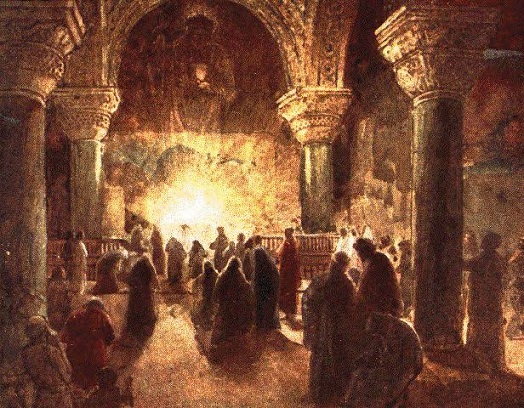This article is part of a series on Old Testament Christophanies. For important background information, see An Introduction to Old Testament Christophanies–with Justin Martyr.

Ezekiel’s final vision of the Son of God is found in Ezekiel 43. This vision is of a future event, when the glory of Yahweh will fill the temple built during the Millennium.[1] What Ezekiel describes further connects the glory of Yahweh from the previous visions to the Son of God.
The hand of Yahweh came upon Ezekiel in the “twenty-fifth year of our exile, at the beginning of the year, on the tenth of the month, in the fourteenth year after the city was taken,” which is equivalent to April 19, 573 BC. In the vision, the Lord brought Ezekiel to the top of a very high mountain, where the millennial Jerusalem will be located. It was on this Jerusalem mountain where Ezekiel was introduced to an angelic guide who looked like he was made of bronze (Ezek 40:1–3). Like with the cherubim, the guide reflected the Lord’s glory. In Ezekiel 40–42, the prophet observed the guide as he measured the temple complex.
At the opening of Ezekiel 43, Ezekiel’s guide led him to the east gate in the outer wall of the millennial temple (v. 1). And then Ezekiel saw a most welcome sight:
and behold, the glory of the God of Israel was coming from the way of the east. And His voice was like the sound of many waters; and the earth shone with His glory. And it was like the appearance of the vision which I saw, like the vision which I saw when He came to destroy the city. And the visions were like the vision which I saw by the river Chebar; and I fell on my face. And the glory of the LORD came into the house by the way of the gate facing toward the east. And the Spirit lifted me up and brought me into the inner court; and behold, the glory of the LORD filled the house (Ezek 43:2–5).
Because the glory of God appeared as it had in Ezekiel’s previous visions, what the prophet saw was the glowing and fiery man, surrounded by a rainbow, entering the temple. His voice was “like the sound of many waters,” and His glory illuminated the land as He passed over it. When Jesus appeared in His glory to the Apostle John on the isle of Patmos, His voice was “like the sound of many waters” (Rev 1:13–16). The glory entering through the millennial temple’s east gate was a reversal of the glory’s departure from the first temple’s east gate. Jesus will return in a manner that reverses both the glory’s departure from Jerusalem and His own. Before Jesus enters Jerusalem at the Second Coming, He will stand on the Mount of Olives, east of the city (Zech 14:4; Acts 1:9–12). And Jesus said that His coming will be like lightning coming from the east and flashing to the west (Matt 24:27). Jesus will come in such glory that every eye will see Him (Rev 1:7).
With his guide standing next to him, Ezekiel heard the Lord speaking from the temple. He said, “Son of man, this is the place of My throne and the place of the soles of My feet, where I will dwell among the sons of Israel forever” (vv. 6–7). Before, Ezekiel had seen the preincarnate Messiah. Now, Ezekiel had seen the incarnate Messiah come to sit on His throne in the millennial temple. The throne being in the temple symbolizes the offices of priest and king being united in one person (Zech 6:13). In the Millennium, the Israelites will fully trust in Jesus as Lord and Savior, so He will dwell among them forever.
The Lord said that the Israelites would never again defile His holy name by committing idolatry with only the wall of the temple between, “Me and them” (vv. 7–8). The Targum replaced “Me and them,” with “My Word and them.”[2] The Lord promised that if the Israelites would stop committing idolatry, then He would dwell among them forever. He then told Ezekiel to describe the temple to the Israelites. And if they were ashamed of their iniquities then Ezekiel was to reveal to them the intricate design of the temple and its laws. The governing law of the temple is that the entire area around where it will sit on the mountaintop will be “most holy” (vv. 9–12). The holiness of the Holy of Holies will extend far beyond the innermost chamber. Everything in and around the temple will be holy. This can and will only come about when King Jesus is reigning over Israel.
As his vision continued in Ezekiel 44, the prophet again saw the glory of Yahweh fill the millennial temple (v. 4). (The glory might have still appeared as the glorified man, though it isn’t clear.) The Lord used this second occurrence to impress upon Ezekiel the importance of the statutes and laws of the temple (v. 5). These statutes and laws are meant to protect the holiness of the Messiah’s future home.
[1] The one-thousand-year reign of Christ on earth (Rev 20:1–7; see 5:9–10). The temple and the area around it described in Ezekiel 40–48 can only exist in the Millennium. The Messiah (the “Branch”) will oversee the temple’s construction after He returns (Zech 6:12–13). The Messiah’s presence in the temple causes miracles to flow from it (Ezek 47:1–12). And there is no temple in the New Jerusalem (Rev 21:22), which will come down from heaven after the Millennium has ended (Rev 21:1–2).
[2] The Targum of Ezekiel: Ezekiel 43:8.

Yahshua is the VINE John 15………….not Branch
Joshua is THE BRANCH zech 3 the prodigal son, filthy and repents, to then serve YHWH/ servant David….ezekiel 34:23….David is his last name he is (sur named) isa: 45:4
Jer: 23 Jer: 33 Isa: 11 The Branch………Ezekiel 37:24-26. YHWH can raise up a Stone to be Abraham if He wants……….John Baptist said……….YHWH has raised up another to lead with the ROD of Iron………Yahshua gives it to him REV: 2:26 ……………you need eyes that can see to understand this.
The “Branch” is almost universally recognized by Christians and a large percentage of Jews as referencing the Messiah. Obviously Joshua, as a Levite, was not claiming to be a king in Zechariah 6. Joshua was, however, teaching what the coming Priest King would do.
Yes, Jesus is also a vine. But Jesus saying that was a different context than the messianic prophecies about the Messiah being a branch.
There are different schools of thought on the meaning of when is meant by passages such as Ezekiel 40-48 as pertaining to the millennial kingdom. Its clear from Hebrews 7-10 that we have a better covenant, with a better priesthood, with a better sacrifice, and that the old covenant is no more. So whatever is happening in Ezekiel, we can be sure we are not going to be going backwards to the old covenant sacrificial system for purposes of atonement. Christ is the wonderful fulfillment of those shadows and types found in the old covenant.
The way I see it there are two main possibilities. I’m not dogmatic about either one. Nor do I think it is that consequential what view a person takes, so long as they recognize the better covenant/priesthood/sacrifice of Christ and that we won’t be going backward. The first possibility is that this is symbolic language, or an allegory of sorts, that describes the Lord’s Temple today–that being the body of Christ.
There are good arguments for this. Among those is the river that flows from the Temple steps (47:1-12) and the fact that Jerusalem is never named in Ezekiel’s temple vision. I’m reminded of Jesus telling the woman at the well the He would give a saved man “a well of water springing up into everlasting life” (John 4:14). Was this a literal well inside of a person? No. It’s an allegory of the power and work of the Holy Spirit inside a person. Could the river coming out of the temple in Ezekiel’s vision, and well of water that Jesus said would spring up inside the one who is born again, be describing the same thing? I think so.
Ezekiel describes the Lord’s presence returning to the Temple (Ezek. 43), like it did when the tabernacle and Solomon’s temple were first built (Ex. 40:34-38; 2 Chron. 7:1-3). In Acts 2 we see the Lord’s presence falling upon His new Temple–the body of Christ. There is no debate that we are the new Temple indwelt with His Holy Spirit (I Cor. 6:19-20; II Cor. 6:16; I Pet. 2:4-5).
In Ezekiel’s vision the name of the city is “The Lord is there” (Ezek. 48:35). In what city does the Temple of God exist today? It’s not a singular location, unlike the days of the old testament where He dwelled with His people in Jerusalem. Why? Because God’s Spirit now indwells believers all over the world, and “the Lord is there.” This is also consistent with the new testament’s characterization of Zion, the heavenly Jerusalem. Namely, that Zion is the people of God.
In Ezekiel’s temple sacrifices are made. In God’s Temple today sacrifices are also made (Rom. 12:1; Phil. 2:17; 4:18; I Pet. 2:5; 2 Cor. 2:15-16; Heb. 13:15; Ps. 107:22, etc.). At the same time there are good arguments against this allegorical approach. This Temple in Ezekiel is described in great specificity. Opponents argue that these details can’t possibly mean it’s allegorical.
The other possibility is that it is a real, literal Temple that will established during the Millennial Reign. This would suggest, however, that in the millennium believers are no longer His Temple, and that he won’t dwell with them all over the world. That instead, He will have a physical temple in a singular location, like the days before we had a better covenant, and that real animal sacrifices will be made.
We know we won’t be going back to the old covenant because we have something better: the once for all sacrifice of Christ and his unchangeable priesthood. That said, perhaps these sacrifices are a memorial of sorts for the millennial kingdom that point comers back to the ultimate sacrifice of Christ.
It’s certainly not out of the realm of possibility. For instance, today in the church we have the memorial of the Lord’s Supper, bread and grape juice that symbolize the broken body and shed blood of Christ. And when we partake in this memorial we show the Lord’s death till He comes. This memorial doesn’t save us, it simply points us to Christ who does save us.
Perhaps after the Lord comes He will establish a new memorial involving animal sacrifices, as people come to a specific location once again in an earthly Jerusalem to meet with the Lord. Not for purposes of atonement, because we know Christ’s atonement is all we need, but rather as a memorial to point people back to the true lamb of God who takes away the sin of the world.
Thank you for the comment. Yes, there are different schools of thought. But there is only one that is consistent with a literal, grammatical, historical hermeneutic. In this current series I cannot get into the nature of the future temple. However, I cover the millennial temple and how the sacrificial system is in harmony with Hebrews in my book here:https://www.amazon.com/One-Thousand-Years-Jesus-Messianic/dp/1532610718/ref=sr_1_1?crid=15RO2BKKI563G&keywords=one+thousand+years+with+jesus&qid=1655847898&sprefix=one+thousand+years+with+jesus%2Caps%2C138&sr=8-1 And a briefer discussion is found here: http://appleeye.org/2013/05/24/the-sacrifices-performed-in-the-millennial-temple-are-in-harmony-with-that-of-the-messiah/
Rapture Imminent 84/85
Very Soon ….
True Christian’s rejoice 😇😇😇😇